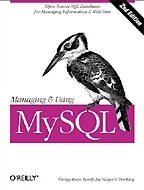

Дата отгрузки на данный момент неизвестна.
Товар закончился у основного поставщика, и, после получения заказа от вас, мы закажем его у других поставщиков. Мы не можем гарантировать выполнение данного заказа, поэтому настоятельно не рекомендуем заказывать данный товар, используя предоплату (банковский перевод и т.п.). Заказ на такой товар действителен в течение 3 недель (если в течение 3 недель товар не придет, заказ будет отменен). Однако, это не означает, что товар нельзя заказать вновь, поскольку в некоторых случаях возможны и более поздние поставки.
Технические характеристики
MySQL, an open source database, has become one of the most popular server software packages. Its developers have provided a rich range of features in a database engine that requires very modest memory and CPU support. Consequently, a huge number of Linux and Unix servers (along with some Windows servers) use MySQL as their database engine. Because it is particularly fast and convenient as a back-end to a web site, MySQL provides the M in the popular term LAMP (for Linux, Apache, MySQL, and Peri, Python, or PHP). Attention to standards has made it easy to move between MySQL and more feature-loaded databases such as open source PostgreSQL or the commercial Oracle and Sybase databases. This book is comprehensive and practical, covering basic information for new database administrators and programmers along with advanced material on security, optimization, and program design. Both tutorial and reference information is included. This edition retains the best features of the first edition, while adding the latest information about MySQL 4.0.1 and the relevant programming language interfaces.